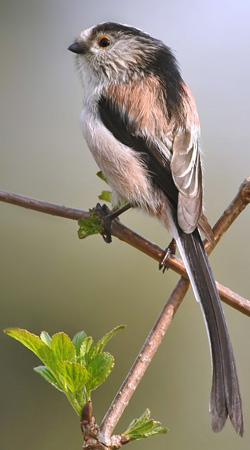Aegithalidae – Bush Tits

The bushtits Aegithalidae, are a family of small, drab passerine birds with moderately long tails. The family contains 11 species in four genera, all but one of which are found in Eurasia (the other is in North America). Bushtits are active birds, moving almost constantly while they forage for insects in shrubs and trees. During non-breeding season, birds live in flocks of up to 50 individuals. Several bushtit species display cooperative breeding behavior, also called helpers at the nest.
All the Aegithalidae are forest birds, particularly forest edge and understory habitats. The species in the genus Aegithalos prefer deciduous or mixed deciduous forests, while the tiny pygmy tit is found mostly in montane coniferous forest. The bushtit is found in a wide range of habitats, including on occasion sagebrush and other arid shrublands, but is most common in mixed woodland. Most species in this family live in mountainous habitats in and around the Himalayas, and all are distributed in Eurasia except the American bushtit, which is native to western North America. The long-tailed tit has the most widespread distribution of any species of Aegithalidae, occurring across Eurasia from Britain to Japan. Two species in contrast have tiny distributions, the Burmese bushtit, which is entirely restricted to two mountains in Burma, and the pygmy bushtit, which is restricted to the mountains of western Java.
The species in this family are generally not migratory, although the long-tailed tit is prone to dispersing in the northern edges of its range (particularly in Siberia). Many mountainous species move to lower ground during the winter.
They are omnivorous, primarily eating insects and other invertebrates such as leafhoppers, treehoppers, aphids, scale insects, and caterpillars. Plant material, such as berries or seeds, is taken occasionally during the winter. The family generally forages arboreally, usually in the shrub layer or canopy, and seldom visits the ground. Prey is generally gleaned from branches, leaves and buds. Less frequently, prey is taken in the air. While foraging, this agile family may hang upside down on branches (although this behaviour is not thought to occur in the tit-warblers) and even manipulate branches and leaves in order to locate hidden food.
Birds in this family live in flocks ranging from 4 to 50 individuals. Flocks form as soon as one breeding season finishes and last until the next one begins. They maintain contact with “churring” calls; their songs are quiet. Other species of birds, such as tits or warblers, will occasionally joining the flock to forage.
The family generally has a monogamous breeding system. Pairs may be aided by helpers, where a related individual (or more than one) helps the established pair raise the young. This has been recorded in at least four of the species; further research is required to see if the behaviour carries over to other members of the family.
Aegithalids make domed, bag-like, nests of woven cobwebs and lichen, which they line with feathers. They make the nests in trees with thick foliage, making them difficult for predators to find. The clutch generally comprises 6 to 10 white eggs, which in many of the species have red speckles. Adults incubate the eggs for 13 to 14 days; young stay in the nest for 16 to 17 days. In at least four of the species (the long-tailed tit, the American bushtit, the black-throated bushtit, and silver-throated bushtit), only the female incubates. Young chicks are fed exclusively on insects and spiders
There are generally thought to be 13 species in this family, as set out below:
Long-tailed Tit Aegithalos caudatus
Silver-throated Bushtit Aegithalos glaucogularis
White-cheeked Bushtit Aegithalos leucogenys
Black-throated Bushtit Aegithalos concinnus
White-throated Bushtit Aegithalos niveogularis
Rufous-fronted Bushtit Aegithalos iouschistos
Black-browed Bushtit Aegithalos bonvaloti
Burmese Bushtit Aegithalos sharpei
Sooty Bushtit Aegithalos fuliginosus
White-browed Tit-warbler Leptopoecile sophiae
Crested Tit-warbler Leptopoecile elegans
Pygmy Bushtit Psaltria exilis
American Bushtit Psaltriparus minimus
-
American Bushtit Psaltriparus minimus
BirdLife Species AccountBirdLife species profile -
American Bushtit Psaltriparus minumus
Species AccountThe American bushtit (Psaltriparus minimus) is the only species in the family Aegithalidae found in the New World, and the only member of the genus Psaltriparus. In North America, it is referred to simply as "bushti -
American Bushtit Psaltriparus minumus
Cornell Species AccountBushtits are sprightly, social songbirds that twitter as they fly weakly between shrubs and thickets in western North America. Almost always found in lively flocks, they move constantly, often hanging upside down to pick at insects or spiders on the undersides of leaves. -
Long-tailed Tit Aegithalos caudatus
Species AccountThe long-tailed tit or long-tailed bushtit (Aegithalos caudatus) is a common bird found throughout Europe and Asia. The genus name Aegithalos was a term used by Aristotle for some European tits, including the long-tailed tit. -
Long-tailed Tit Aegithalos caudatus
RSPB Species AccountThe long-tailed tit is easily recognisable with its distinctive colouring, a tail that is bigger than its body, and undulating flight. -
Long-tailed Tit Aegithalos caudatus
Image, species account and call….
-
Number of bird species: 13
